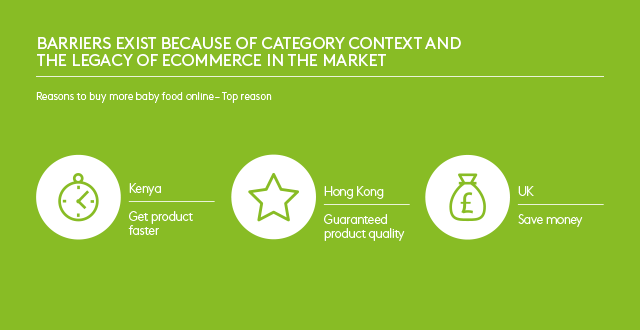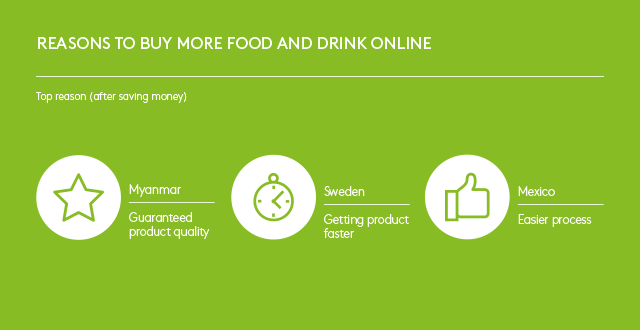Bill Gates once described the internet as the “town square for the global village of tomorrow”. It’s a town square that supports a rich diversity of shops and shopping experiences. Look across markets, and you quickly discover that not only do people buy things online through different platforms and in different ways – they also do so for very different reasons. In order to grow their share of ecommerce in any given region or country, marketers must understand the nuances of the particular part of the town square they are dealing with.
Different constraints – and different ways to overcome them
Some areas of the virtual town square can prove very difficult to build shops in. From Mexico to India and Kenya to Cambodia, there are many markets where the ecommerce landscape is shaped by lack of infrastructure: the challenges of people getting online, a lack of payment mechanisms, or huge logistical shortcomings. These business-side barriers may limit the size of an ecommerce market to the extent that ecommerce providers can’t function profitably – a problem encountered by the product discovery platform InMobi for example, which has been forced to centralise operations across different African markets in an attempt to overcome it. In many cases though, powerful drivers for shopping online – and therefore powerful opportunities for brands – do exist, despite the challenges involved. Opportunity comes from understanding how and why people in a given market are motivated to buy online – and facilitating a purchase experience that adds up for them.
The shifting value of shopper currencies
All shopping involves people trading off the different currencies of time, money and energy – and the decision to shop online is no different. However, the compromises involved can vary significantly from market to market – and from category to category.
In Indonesia for example, the difficulty and expense of delivering goods across a far-flung archipelago of islands makes it unrealistic for online orders to arrive quickly and cheaply. As a result, low prices and speed of delivery aren’t powerful drivers for buying online – but being able to access a greater range of products certainly is. In many African countries, massive unregulated shadow economies mean consumers can often buy from a street vendor (who pays no taxes on his or her goods) far more cheaply than they can from an online store. In this case, low prices aren’t the key advantage to buying online – but dealing direct with a brand and being more confident of product quality often can be.
In this way, local concerns and priorities dictate the true appeal of ecommerce. In the UK, for example, the most compelling driver for buying baby food online is to save money (chosen by 47% of people in this year’s Connected Life study from Kantar). In Hong Kong, where consumers encounter frequent headlines about food safety scandals, it’s the guarantee of product quality that is most likely to motivate people (31% name it as their primary reason for buying online). In rural areas of Kenya served through traditional trade, searching for a particular brand of baby food might involve travelling a considerable distance to a place that stocks it. Buying online won’t necessarily obtain the product more cheaply – however it will usually enable it to be obtained faster, something 33% of Kenyan shoppers identify as a reason for buying more online.

Saving money isn’t the only reason for shopping online
The promise of a lower price is often the most important feature of ecommerce in consumers’ eyes – but not always. In emerging Asian markets such as Vietnam, Myanmar and Indonesia, product quality is the major motive for buying food and drink online. Quality is also the most important factor for Peruvians, Chinese and South Africans buying cosmetics – and it also tips the balance in favour of online for fashion shoppers in Turkey, Nigeria, Kenya and Myanmar.

Closely associated with the guarantee of product quality is the appeal of forming a direct relationship with a brand rather than buying through intermediaries. This is important to those buying non-alcoholic drinks online in Hong Kong and Indonesia (where it comes out ahead of price).
In higher consideration categories, the ability to access exotic products that are otherwise unavailable becomes a defining feature of ecommerce propositions. This is named as a driver by a quarter of fashion shoppers in Australia, New Zealand, the UK, US and Finland – and features strongly as a driver for cosmetics shoppers as well.
The trade-offs involved in buying online can also vary between urban and rural areas within the same market. Within ‘Tier 1’ cities, a wider range of products can often be obtained quickly through a simple trip to the local market – especially if those cities have a more established modern trade infrastructure. Price becomes a more important trigger for buying online – and efficient logistics mean that eCommerce providers are better able to deliver on it.

Building innovative propositions around shopper priorities
When equipped with an understanding of the real motives for shopping online, brands are able to innovate new customer experiences that work around logistical barriers to deliver against those priorities. This often involves integrating online shopping with the rhythms and experiences of traditional trade that still dominate in many markets. In India, for example, Hindustan Unilever Ltd partners with small, neighbourhood ‘kirana’ stores allowing shoppers to collect the goods they order. This makes perfect sense when you consider that an easy, accessible process is a factor Indians consistently say would persuade them to spend more online.
Fusing offline and online experiences in this way can play a key role in overcoming some of the barriers to ecommerce. The Nigerian online shopping platform Jumia sends representatives to neighbourhoods, equipped with tablet devices, to help residents with the process of placing online orders. It’s an approach that might make little commercial sense in markets with widely established internet access – but Jumia recognises the importance of building trust in order to gain share once online shopping is ready to expand. Similarly the Indonesian fashion website Zalora, receives an extremely high number of customer service phone calls – an average of one for every customer placing an order on its site. This reflects the lack of confidence and familiarity with ecommerce even amongst those Indonesians that are happy to buy online. Providing such intensive customer service can seriously erode profit margins (by comparison, European fashion sites receive queries on only 5 per cent of orders). However, Zalora sees this as a necessary investment for building all-important trust in the market.
Focus on triggers to secure first-mover advantage
Focusing on the motives for shopping, as well as the barriers that may prevent it, is all the more important when those barriers can suddenly disappear. In India, a lack of banking and credit card services has limited ecommerce through the need for people to pay for goods through cash on delivery. Then, on November 9th, the government outlawed high-denomination 500 and 1,000 rupee notes overnight, making such transactions far more difficult. As a result, take-up of digital wallet services increased exponentially with providers reporting five-fold increases in daily transactions and customer numbers doubling on a daily basis, according to the Times of India. One of the major constraints for online shopping (Indians’ lack of appetite for cashless payment systems) is suddenly being removed.
In circumstances such as these, when ecommerce hits a sudden potential tipping point, the brands that have already built up trust in online shopping experiences are most likely to benefit. This is why Jumia is prepared to invest in its travelling tablet-toting sales assistants – and why Zalora backs up its ecommerce services with hard-working call centres. Rather than waiting for a standard, global ecommerce experience to emerge, they have shown the appetite for understanding the triggers and barriers along the path to purchase, and building local solutions that resonate with the way people trade off time, money and energy. This gives ecommerce its broad range of distinct local accents – and is the key to growing brand share of online spending in any given market.


